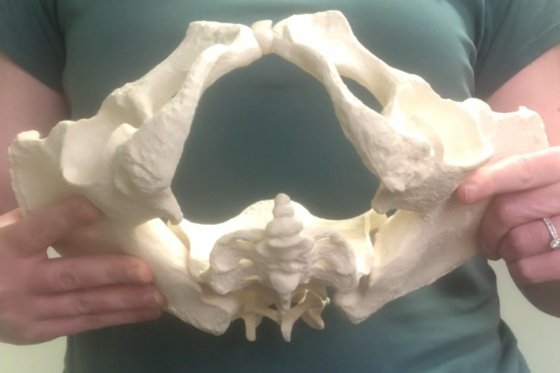“The pelvic floor lives in the cage of the pelvis”-Hayley Kava
What does this mean?
When I first heard this quote from one of my mentors, I had difficulty understanding what she meant. Then after listening and talking to her more, it really hit home so now I want to impart this knowledge on you.
The pelvis is made up of 3 bones, each half pelvis is called an innominate bone and then there is the triangular bone in the back called the sacrum. These 3 bones make the pelvic bowl with the pelvic floor muscles being the hammock at the bottom connecting the 3 bones together.
Although the pelvic floor muscles attach on the bottom of the pelvis, many muscles attach to various points around the pelvis. These muscles include the abdominals, latissimus dorsi, paraspinals, hamstrings, adductors, and glutes to name of few.
We love to think we are symmetrical human beings, but I am here to tell you that we are not. In the “perfect symmetrical” pelvis, it would look like this:
Front view of a “perfectly symmetrical” pelvis
View from the bottom if the pelvic bones are sitting symmetrically. Notice a good balance in positioning from front to back and side to side.
Our underlying pattern is one where the left side is typically tipped more forward, out and open while the right side is the exact opposite. The right side is typically tipped more backward, in and closed. When this happens, it changes how the pelvic floor muscles sit as seen below.
This creates areas of the pelvic floor where the muscles are sitting in shortened, tight position while other areas are pulled in more elongated, taut positioning changing how they fire and absorb pressure.
Front view with the pelvis in our typical underlying pattern. Notice the left side is more open, forward and out. Right side is more back, in, and closed
View from the bottom demonstrating that this position placing some areas of the pelvis closer together (and therefore, would place the pelvic floor muscles in the area in a shortened position) and other areas further away (placing muscles in this area in an elongated position)
Another option, is sometimes people are more forward, open, and out (especially in pregnancy but not always). In this position, you can see the back side of the pelvic floor is closer together putting these muscles in shorter positions while the front of the pelvis positions muscles more elongated.
Front view showing both sides of the pelvis sitting more forward, open and out. Very common during pregnancy but can also be found in non-pregnant population as well.
View from the bottom demonstrating back side of pelvis more narrow and front side more elongated.
Why does this matter? Well, all those other muscles outside the pelvic floor that are listed above (hamstrings, adductors, etc) can asymmetrically pull on the pelvis changing how the pelvic floor fires. And I can tell you, no one’s pelvic floor is strong enough to out stretch or out contract one of these external muscles. (If you have a tight hamstring pulling on 1 side of the pelvis, that side of the pelvic floor will likely never be able to contract stronger to readjust the position of the pelvis). But there’s good news! You can work on repositioning how the pelvis is sitting and work on improving the range of motion of the pelvis to move in and out of these asymmetrical patterns to allow the pelvic floor to fire and function how you want it to 😀
This is often why we have to look outside the pelvis to treat pelvic floor issues.







